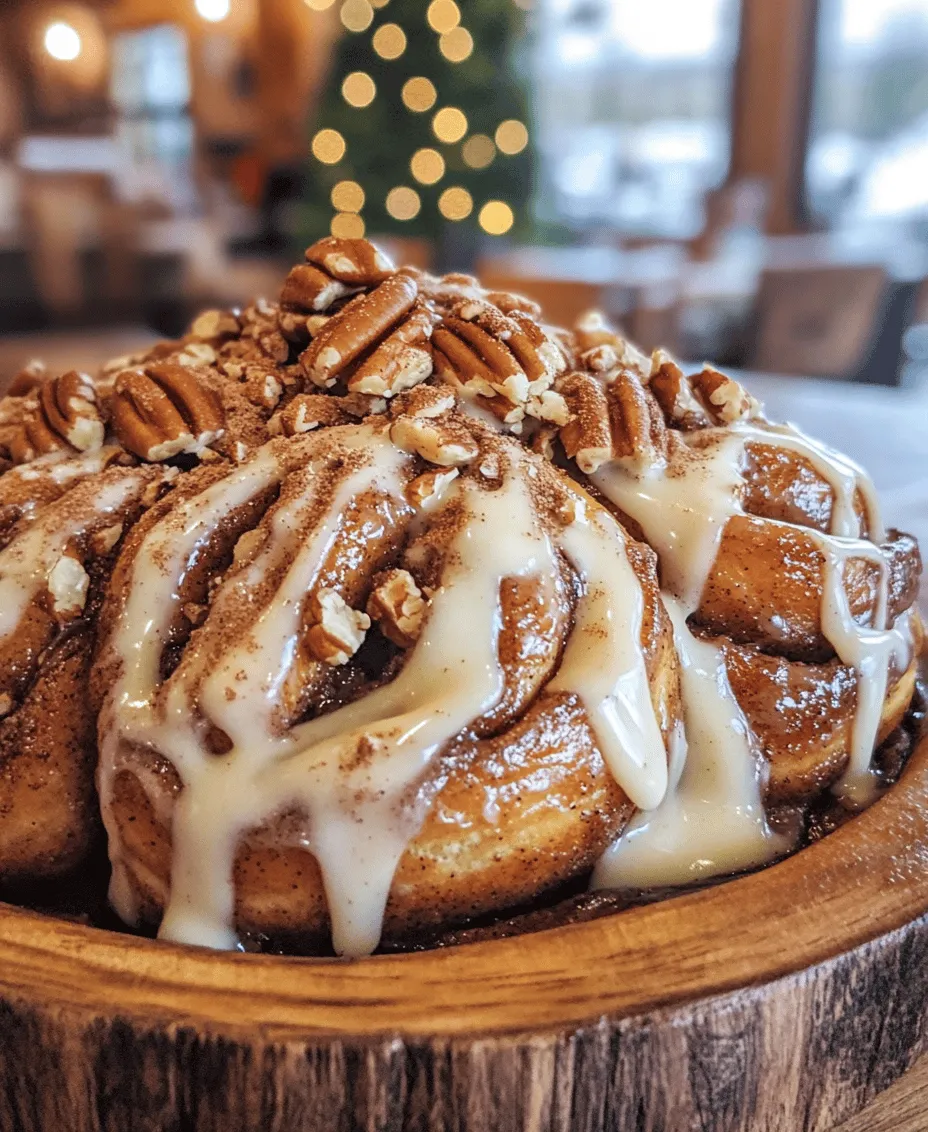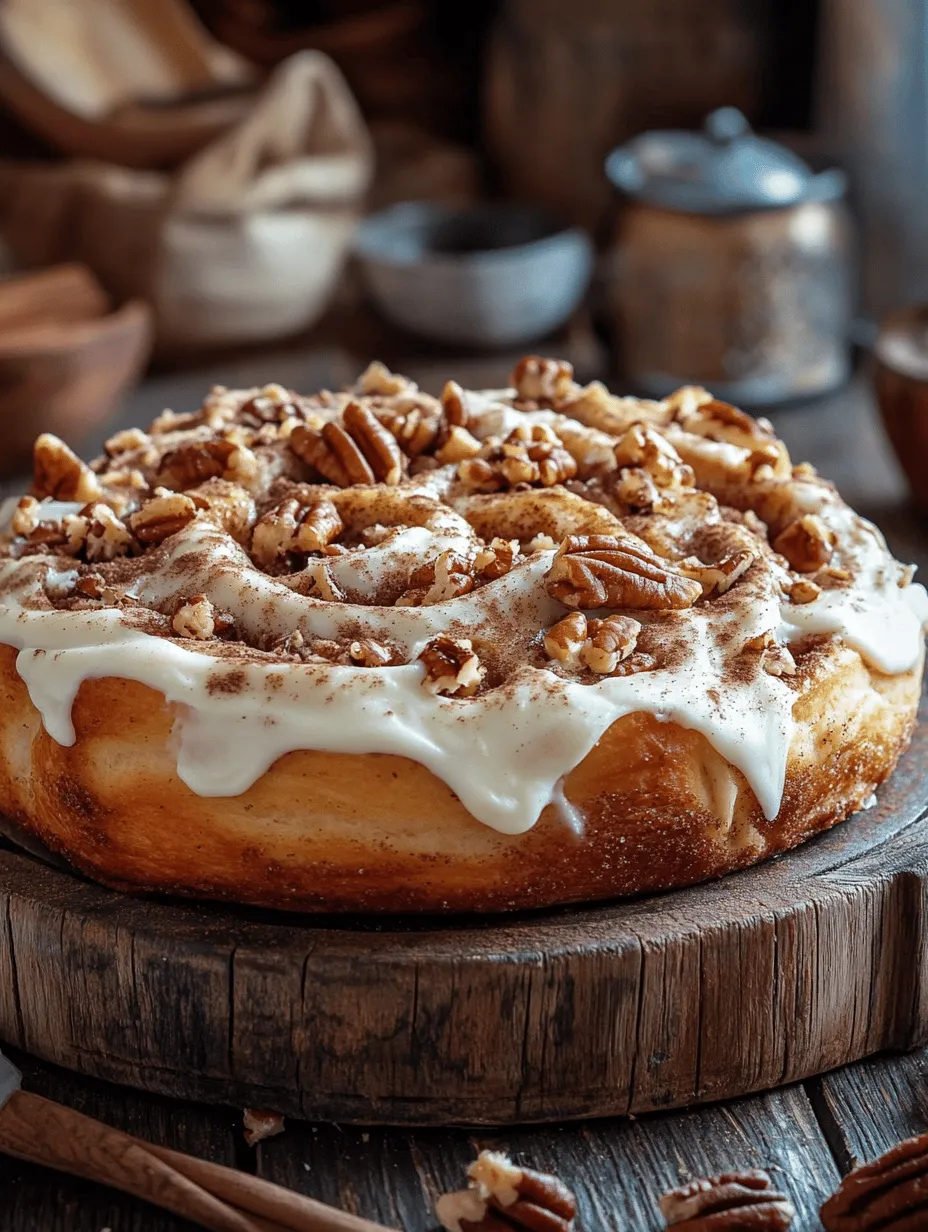Introduction
There’s something incredibly comforting about the aroma of fresh cinnamon rolls wafting through the house, inviting everyone to gather around the kitchen. Homemade cinnamon rolls are more than just a delicious pastry; they embody warmth, nostalgia, and the simple joy of baking. Whether it’s a cozy weekend morning or a festive holiday gathering, the sight of golden, spiral rolls topped with creamy frosting can instantly uplift spirits and create lasting memories.
To achieve that perfect, melt-in-your-mouth experience, it’s crucial to use the right ingredients and techniques. Each component plays a vital role in ensuring your cinnamon rolls are soft, fluffy, and bursting with flavor. In this article, we will guide you through the detailed steps to create the best cinnamon rolls, from understanding the essential ingredients to perfecting the dough. Get ready to embark on a delightful baking journey that will fill your home with sweet aromas and your heart with joy.
Understanding the Ingredients
The Essential Components of Cinnamon Rolls
Before diving into the recipe, it’s essential to familiarize yourself with the key ingredients that make up the foundation of incredible cinnamon rolls. Here’s a breakdown of what you’ll need:
– Flour: All-purpose flour is typically used for the dough, providing the necessary structure and texture. The gluten in the flour helps the dough rise and gives it that desirable chewy texture.
– Sugar: Granulated sugar not only sweetens the dough but also contributes to browning during baking, resulting in a beautiful golden crust. Brown sugar is often used in the filling to enhance moisture and add depth of flavor.
– Yeast: Active dry yeast or instant yeast is crucial for leavening the dough. It ferments and produces carbon dioxide, causing the dough to rise and become light and airy. Make sure your yeast is fresh for the best results.
– Milk: Warm milk hydrates the dry ingredients and activates the yeast. The fat in milk also enriches the dough, contributing to its tenderness.
– Butter: Using unsalted butter adds richness and flavor to the dough. It also helps create a soft texture by coating the flour particles, preventing them from forming too much gluten.
– Eggs: Eggs enrich the dough, providing moisture, flavor, and structure. They also help with the dough’s rise and contribute to its golden color.
Each ingredient plays a distinct role, and understanding their contributions is the first step toward mastering the art of cinnamon roll making.
Exploring Variations in Fillings and Toppings
While the traditional cinnamon-sugar filling is beloved, you can customize your cinnamon rolls to suit your taste. Here are some optional ingredients to consider:
– Nuts: Chopped pecans or walnuts can be added to the filling for a delightful crunch. They pair well with the sweetness of cinnamon and sugar.
– Dried Fruits: Raisins or dried cranberries can add a burst of flavor and texture. Soak them in warm water or rum beforehand for extra moisture and richness.
– Cream Cheese Frosting: A classic topping that perfectly complements the warm spices of the rolls. Cream cheese frosting offers a tangy contrast to the sweetness, making it a favorite for many.
– Alternative Toppings: If cream cheese isn’t your style, consider a simple glaze made of powdered sugar and milk, or a buttery maple syrup drizzle. Each variation brings its unique flair to your rolls.
With these options, you can create a cinnamon roll that reflects your personal taste and elevates the overall experience.
The Dough: Creating a Soft and Fluffy Base
Mixing the Dry Ingredients
To begin crafting your cinnamon rolls, you’ll first need to prepare the dough. Start by gathering your dry ingredients: flour, sugar, yeast, salt, and cinnamon.
1. Combine the Ingredients: In a large mixing bowl, whisk together about 4 cups of all-purpose flour, 1/4 cup of granulated sugar, 2 teaspoons of instant yeast, 1 teaspoon of salt, and 1 tablespoon of ground cinnamon. Be sure to mix these ingredients thoroughly; this ensures that the yeast and salt are evenly distributed throughout the flour, which is crucial for the dough’s performance.
2. Importance of Proper Mixing: Properly mixing the dry ingredients at this stage lays the foundation for your cinnamon rolls. It ensures an even rise and helps to prevent clumping, allowing for a consistent texture throughout the dough.
Incorporating Wet Ingredients
Once your dry ingredients are mixed, it’s time to introduce the wet ingredients. These will bring your dough to life.
1. Heat the Milk: In a small saucepan, heat about 1 cup of whole milk until it’s warm but not boiling—around 110°F (43°C) is ideal. This warmth is essential as it activates the yeast and helps the dough rise effectively.
2. Add Melted Butter and Eggs: While the milk is warming, melt 1/4 cup of unsalted butter. Once melted, allow it to cool slightly before combining it with the warm milk. Crack in 1 large egg and whisk until everything is well combined.
3. Mix Wet and Dry: Pour the wet mixture into the bowl of dry ingredients. Using a wooden spoon or a spatula, stir everything together until a shaggy dough begins to form.
Kneading for Perfection
Kneading is a crucial step in developing the gluten structure of your dough, which contributes to the chewy, airy texture of your cinnamon rolls.
1. Knead the Dough: Transfer the dough onto a lightly floured surface. With floured hands, begin to knead the dough by folding it over itself and pushing it down with the heel of your hand. Rotate the dough a quarter turn between kneads.
2. Identifying the Right Consistency: Continue kneading for about 5-7 minutes until the dough is smooth and elastic. If you poke it with your finger, it should spring back. If your dough feels too sticky, sprinkle in a little extra flour, but be cautious not to overdo it; too much flour can lead to dense rolls.
The First Rise
The first rise is where the magic happens. It allows the yeast to work its wonders, causing the dough to double in size.
1. Prepare for Rising: Form the kneaded dough into a ball and place it in a large bowl greased with butter or oil. Cover the bowl with a clean kitchen towel or plastic wrap to trap warmth.
2. Ideal Conditions: Allow the dough to rise in a warm, draft-free environment for about 1-2 hours, or until it has doubled in size. You can create a warm environment by turning on your oven for a minute, then turning it off and placing the dough inside.
3. Checking Readiness: To check if the dough is ready, gently press your finger into it. If the indentation remains, the dough has risen sufficiently.
Crafting the Filling: The Heart of the Cinnamon Rolls
Mixing the Filling Ingredients
Now that your dough has risen, it’s time to prepare the filling, which is the heart and soul of your cinnamon rolls.
1. Creating the Cinnamon-Sugar Mixture: In a medium bowl, mix together 1 cup of brown sugar, 2 tablespoons of ground cinnamon, and a pinch of salt. This mixture will provide the sweet and spicy flavor that cinnamon rolls are known for.
2. Optional Ingredients: If you’re adding nuts or dried fruits, chop them and mix them in with the cinnamon-sugar mixture. This step adds texture and flavor variety to your rolls.
Rolling Out the Dough
Once your filling is ready, return to your dough.
1. Prepare the Surface: Lightly flour your work surface. Roll out the risen dough into a large rectangle, approximately 16×12 inches and about 1/4 inch thick.
2. Maintaining Elasticity: If the dough springs back when you try to roll it, let it rest for a few minutes before continuing. This relaxation allows the gluten to loosen, making rolling easier.
Applying the Filling
With your dough rolled out, it’s time to apply the filling.
1. Spread the Filling: Using a spatula or your hands, spread 1/2 cup of softened butter over the entire surface of the dough. Then, evenly sprinkle the cinnamon-sugar mixture over the buttered dough, making sure to cover every inch.
2. Rolling the Dough: Starting from the long edge of the rectangle, carefully roll the dough tightly into a log. Ensure that you roll it evenly to maintain a uniform thickness throughout.
These initial steps are critical in crafting the best cinnamon rolls. The attention to detail from ingredient selection to dough preparation sets the stage for an exquisite final product. As we continue to explore the remaining steps, your kitchen will soon be filled with the delightful scent of cinnamon rolls baking to perfection. Stay tuned for detailed instructions on cutting, second rising, baking, and frosting your rolls for that ultimate finish!

Strategies for Spreading the Filling Evenly
When it comes to crafting the best cinnamon rolls, the filling is crucial for that signature flavor and sweetness. To spread the filling evenly, begin by softening your butter to a spreadable consistency—this will make it much easier to glide across the dough. Using an offset spatula or the back of a spoon, start from the center of the rolled-out dough and gently push the filling outwards toward the edges. Aim for a thin, even layer that covers the entire surface of the dough.
To avoid overfilling, remember that less is often more. A good rule of thumb is to use about ½ cup of filling for a 12×18-inch sheet of dough. This amount should provide sufficient flavor without overwhelming the dough. If you feel tempted to add more, consider that too much filling can lead to a mess during the rolling process, making the dough more prone to tearing.
Shaping the Cinnamon Rolls
Rolling and Cutting Techniques
Once the filling is evenly spread, it’s time to roll the dough into a log. Start at one of the long edges of the rectangle, carefully lifting the dough and rolling it tightly towards the opposite edge. It’s essential to keep the roll tight to ensure that the filling is enclosed and the rolls maintain their shape while baking.
As you roll, try to keep the dough taut, but avoid pulling too hard, which can cause tearing. You’ll want to roll it into a cylinder that is uniform in thickness. Once the dough is rolled, use a sharp knife or a bench scraper to slice the log into even pieces. To achieve uniform rolls, cut the log into 12 equal parts, approximately 1.5 inches thick. This will ensure that each roll bakes evenly and is the perfect size for serving.
The Second Rise
The second rise is a crucial step that often gets overlooked. This rise allows the rolls to develop a fluffy, tender texture. After cutting the rolls, place them in a greased baking dish, ensuring a bit of space between each roll to allow for expansion. Cover the dish with a clean kitchen towel or plastic wrap, and let them rise in a warm place for about 30 to 45 minutes.
For best results, you can preheat your oven to its lowest setting, then turn it off. Place the covered rolls inside; the gentle warmth will encourage the dough to rise beautifully. The rolls should double in size during this time.
Baking the Perfect Cinnamon Rolls
Preheating the Oven
Properly preheating your oven is essential for achieving the best cinnamon rolls. Preheat the oven to 350°F (175°C) at least 20 minutes before you plan to bake. This ensures that the rolls start baking immediately when placed inside, promoting even cooking and preventing them from becoming dense. An oven thermometer can be a handy tool to ensure accuracy since many home ovens can be off by several degrees.
Baking Process and Timing
Once your rolls have completed their second rise, it’s time to bake them. Place the rolls in the preheated oven and set a timer for about 25-30 minutes. Keep an eye on them as they bake; they should turn a beautiful golden-brown color. For an accurate measure of doneness, you can insert a toothpick into the center of one of the rolls. If it comes out clean or with a few moist crumbs, the rolls are ready.
Common baking mistakes to avoid include opening the oven door too often, which can disrupt the baking temperature, and overcrowding the rolls in the pan, leading to uneven baking. If you notice that the tops are browning too quickly, you can cover the rolls loosely with aluminum foil halfway through the baking time.
Creating the Cream Cheese Frosting
Mixing the Frosting Ingredients
To complement your cinnamon rolls, a smooth, creamy frosting is a must. Begin by softening 8 ounces of cream cheese and 4 tablespoons of butter at room temperature. In a mixing bowl, combine these with 2 cups of powdered sugar, 1 teaspoon of vanilla extract, and a pinch of salt. Use an electric mixer on medium speed until the mixture is well combined and smooth.
For a thicker frosting, add more powdered sugar gradually until you reach your desired consistency. Conversely, if you prefer a thinner glaze, add a splash of milk or cream until it reaches the right thickness.
Frosting the Cinnamon Rolls
Once the cinnamon rolls have finished baking, allow them to cool for about 10 minutes before frosting. This slight cooling period helps prevent the frosting from melting too quickly. Using a spatula, generously spread the cream cheese frosting over the warm rolls, allowing some to seep into the crevices for an extra indulgent treat. If you want to take it up a notch, consider topping the frosting with chopped nuts, such as pecans or walnuts, for a delightful crunch.
Serving Suggestions and Pairings
Enjoying Freshly Baked Cinnamon Rolls
Freshly baked cinnamon rolls are best enjoyed warm from the oven. You can serve them as a delightful breakfast treat, a sweet snack, or even as a comforting dessert. For an extra touch, sprinkle some additional cinnamon or drizzle a little extra icing over the top before serving.
Pair your cinnamon rolls with a hot cup of coffee or tea to enhance the experience. The richness of the rolls complements the bitterness of coffee perfectly, while a soothing cup of herbal tea can provide a lovely contrast.
Storage and Reheating Tips
If you happen to have leftovers (though it’s hard to imagine that happening), storing them correctly is essential for maintaining their deliciousness. Place the cooled rolls in an airtight container at room temperature, and they’ll stay fresh for about 2-3 days. You can also refrigerate them for up to a week, but keep in mind that refrigeration may alter their texture slightly.
For reheating, simply pop them in the microwave for about 15-20 seconds until warmed through, or place them in a preheated oven at 350°F (175°C) for about 10 minutes. If you want a bit of frosting to melt, add it before reheating, and enjoy the delightful gooeyness.
Conclusion
Baking homemade cinnamon rolls is a joyous experience that brings comfort and satisfaction to the kitchen. The sweet aroma that fills your home as they bake is only rivaled by the delight of sharing them with loved ones. This recipe for the best cinnamon rolls guarantees fluffy, flavorful rolls topped with a luscious cream cheese frosting that will have everyone coming back for seconds.
So gather your ingredients, roll up your sleeves, and embark on this baking adventure. Experience the joy of pulling warm, homemade cinnamon rolls from the oven and savoring each bite. Whether for a special occasion, a holiday breakfast, or simply to treat yourself, these cinnamon rolls are sure to become a favorite in your recipe repertoire. Don’t hesitate to share your delicious results with friends and family—the satisfaction of sharing homemade treats is perhaps the best part of baking!

